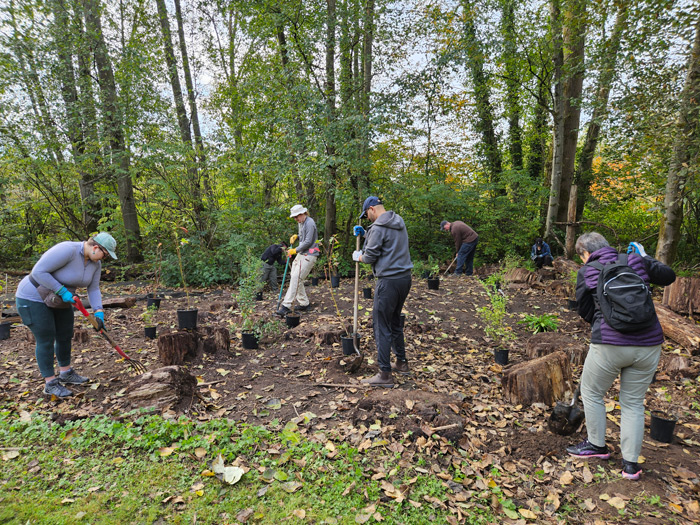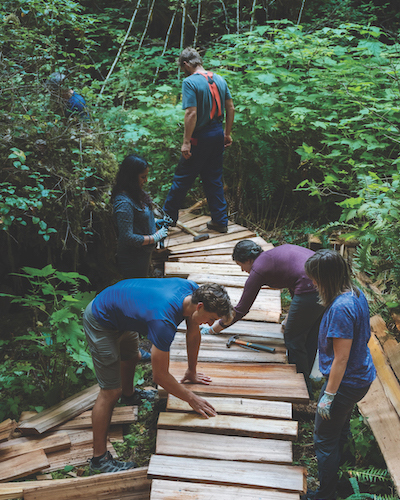Enjoy Nature While Giving Back
If you love getting outside, why not help preserve and protect the environment while you’re out there?
A rescued heron being released on a Vancouver beach.
I put my binoculars down, double-checked the Merlin bird-identification app on my smartphone, then tallied “brown creeper” on my record for that day’s bird count.
It was a happy moment. I hadn’t seen that species in our yard in the seven years since I’d joined Project FeederWatch, a citizen-science program run by Birds Canada in which people record bird species they see in their yard to help scientists track populations.
Project FeederWatch is just one of many ways to give back to nature. If you want to enrich your experiences of nature by giving it a helping hand, you have a multitude of options—some on your own, others with organizations.
One activity that gives you a chance to help a wide range of species is the Nature Conservancy of Canada’s annual Big Backyard BioBlitz. After signing up, you spend a set period of time taking photos, video, and observations of as many plants, birds, insects, mammals, reptiles, and amphibians as you can. (The 2025 BioBlitz runs July 28 to August 2.)
You upload all this data to the free iNaturalist app, which you can download onto your smartphone and/or computer. It’s that easy. And despite the word “backyard,” you can do the BioBlitz anywhere: in your yard, nearby parks or wilderness areas, or simply on your usual walking route.
“Some people don’t have land to donate, some don’t have money to donate,” said Andrew Holland, media relations director for the Nature Conservancy, in a phone interview. “But there’s a whole host of things people can do to help nature, like our BioBlitz.”

“Weedbuster“ volunteers pull invasive weeds at Burnaby Lake Park.
Survey says…
If you’re up for a bigger commitment, consider doing a long-term survey for a nature organization. One example is the annual Canadian Lakes Loon Survey conducted by Birds Canada. Participants choose a lake within the common loon’s breeding range—such as Ruby Lake on the Sunshine Coast or Beaver Lake, northeast of Kelowna—to visit at least three times a year: in June to see if loon pairs are present, in July to see if chicks hatch, and in August to see if chicks have survived long enough to fledge.
Or you could participate in Coastal Partners in Conservation’s painted turtle research by reporting sightings.
Want to make an even bigger commitment? There are ways for you to monitor entire ecosystems. Vancouver-based citizen science community WildResearch, for example, conducts marsh monitoring for coastal and inland wetlands. Trained volunteers watch their marshes, recording information about habitat, birds, and amphibian species in spring and summer. The BC Wildlife Federation also has volunteer opportunities that include stream surveys and wetland plantings.
Lend a hand
If you’re interested in hands-on wildlife work, you can learn how to participate in bird banding to help scientists monitor migrations. Both WildResearch and Victoria’s Rocky Point Bird Observatory welcome volunteer help in carrying out banding: check out their websites for details.
For even more hands-on work, try out rehabilitation. Picking up injured animals and releasing rehabilitated ones is part of it, but you can also expect to feed injured wildlife, clean cages, and work on public outreach.
Some people don’t have money to donate. But there’s a whole host of things people can do.
Several BC rehab organizations welcome volunteers. The Wildlife Rescue Association of BC in Burnaby handles all types of wildlife, while the OWL (orphaned wildlife) Rehabilitation Society in Delta specializes in raptors. On Vancouver Island, the North Island Wildlife Recovery Centre in Errington, near Parksville, always welcomes volunteers.
There are many more wildlife rehab organizations around the province and across Canada. To find one close to you, enter “wildlife rehabilitation near me” into your preferred search engine.
Restore habitat
One of the best ways to give back to nature is to restore habitat. You can do this in small ways, such as establishing bird-friendly plants in your yard and providing a source of water, or larger ones, like taking part in invasive weed pulls, replanting trees, or helping install nest boxes for birds.
Organizations that hold invasives-pulling events include the Burnaby Lake Park Association and North Delta’s Cougar Creek Streamkeepers. The BC Wildlife Federation also holds workshops to teach people how to restore and maintain wetlands. Some last a day, others up to a week.

Wilderness Committee volunteers build trails in Vancouver Island’s Walbran Valley.
Yet another way you can restore habitat is by helping to maintain hiking trails. The Wilderness Committee plans and guides trail-building trips each year in old-growth rainforests on Vancouver Island. According to Wilderness Committee associate director Torrance Coste, the organization holds several trail-building trips between May and September. Trails BC lists many other opportunities for you to help with this important task.
If you prefer something less rigorous than building trails, many naturalist clubs hold field trips that require volunteer guides. Nature Vancouver often needs specialists in birding, botany, and other nature-related sciences for its field trips. If you’re keen to do something like this where you live, visit the “BC Nature Clubs” page of the BC Nature website, which lists more than 60 naturalist groups.
There are many other ways to give nature a helping hand. If there’s an aspect of nature that you feel passionate about, do an online search: you’re bound to find a way to give back.
This story was first published on The Green House, our membership platform. Join us there for early access, discounts and freebies, community discussions, and to support our work telling the large and small stories of how we can live sustainably.
Print Issue: 2025—Issue 1
Print Title: Give Back, Naturally
